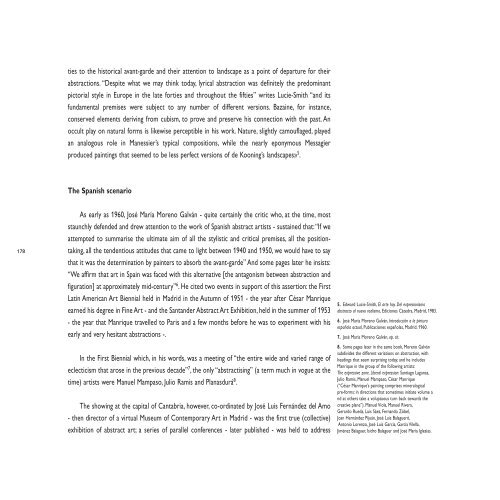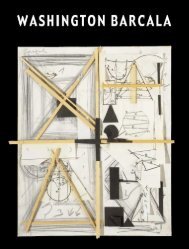VERSIÓN INGLESA ENGLISH VERSION - Fundación César Manrique
VERSIÓN INGLESA ENGLISH VERSION - Fundación César Manrique
VERSIÓN INGLESA ENGLISH VERSION - Fundación César Manrique
Create successful ePaper yourself
Turn your PDF publications into a flip-book with our unique Google optimized e-Paper software.
178<br />
ties to the historical avant-garde and their attention to landscape as a point of departure for their<br />
abstractions. “Despite what we may think today, lyrical abstraction was definitely the predominant<br />
pictorial style in Europe in the late forties and throughout the fifties” writes Lucie-Smith “and its<br />
fundamental premises were subject to any number of different versions. Bazaine, for instance,<br />
conserved elements deriving from cubism, to prove and preserve his connection with the past. An<br />
occult play on natural forms is likewise perceptible in his work. Nature, slightly camouflaged, played<br />
an analogous role in Manessier’s typical compositions, while the nearly eponymous Messagier<br />
produced paintings that seemed to be less perfect versions of de Kooning’s landscapes» 5 .<br />
The Spanish scenario<br />
As early as 1960, José María Moreno Galván - quite certainly the critic who, at the time, most<br />
staunchly defended and drew attention to the work of Spanish abstract artists - sustained that: “If we<br />
attempted to summarise the ultimate aim of all the stylistic and critical premises, all the positiontaking,<br />
all the tendentious attitudes that came to light between 1940 and 1950, we would have to say<br />
that it was the determination by painters to absorb the avant-garde” And some pages later he insists:<br />
“We affirm that art in Spain was faced with this alternative [the antagonism between abstraction and<br />
figuration] at approximately mid-century” 6 . He cited two events in support of this assertion: the First<br />
Latin American Art Biennial held in Madrid in the Autumn of 1951 - the year after <strong>César</strong> <strong>Manrique</strong><br />
earned his degree in Fine Art - and the Santander Abstract Art Exhibition, held in the summer of 1953<br />
- the year that <strong>Manrique</strong> travelled to Paris and a few months before he was to experiment with his<br />
early and very hesitant abstractions -.<br />
In the First Biennial which, in his words, was a meeting of “the entire wide and varied range of<br />
eclecticism that arose in the previous decade” 7 , the only “abstractising” (a term much in vogue at the<br />
time) artists were Manuel Mampaso, Julio Ramis and Planasdurá 8 .<br />
The showing at the capital of Cantabria, however, co-ordinated by José Luis Fernández del Amo<br />
- then director of a virtual Museum of Contemporary Art in Madrid - was the first true (collective)<br />
exhibition of abstract art; a series of parallel conferences - later published - was held to address<br />
5. Edward Lucie-Smith, El arte hoy. Del expresionismo<br />
abstracto al nuevo realismo, Ediciones Cátedra, Madrid, 1983.<br />
6. José María Moreno Galván, Introducción a la pintura<br />
española actual, Publicaciones españolas, Madrid, 1960.<br />
7. José María Moreno Galván, op. cit.<br />
8. Some pages later in the same book, Moreno Galván<br />
subdivides the different variations on abstraction, with<br />
headings that seem surprising today; and he includes<br />
<strong>Manrique</strong> in the group of the following artists:<br />
The expressive zone. Liberal expression: Santiago Lagunas,<br />
Julio Ramis, Manuel Mampaso, <strong>César</strong> <strong>Manrique</strong><br />
(“<strong>César</strong> <strong>Manrique</strong>’s painting comprises mineralogical<br />
pre-forms: in directions that sometimes initiate volume a<br />
nd at others take a voluptuous turn back towards the<br />
creative plane”), Manuel Viola, Manuel Rivera,<br />
Gerardo Rueda, Luis Sáez, Fernando Zóbel,<br />
Joan Hernández Pijuán, José Luis Balagueró,<br />
Antonio Lorenzo, José Luis García, García Vilella,<br />
Jiménez Balaguer, Isidro Balaguer and José María Iglesias.
















![Becas y premios de la Fundación César Manrique [1997-2006]](https://img.yumpu.com/20766851/1/184x260/becas-y-premios-de-la-fundacion-cesar-manrique-1997-2006.jpg?quality=85)
